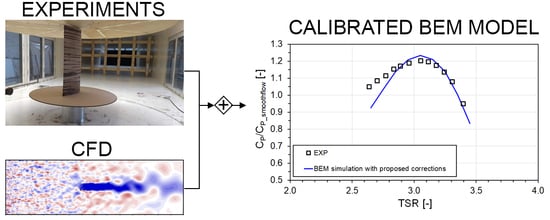Understanding the Aerodynamic Behavior and Energy Conversion Capability of Small Darrieus Vertical Axis Wind Turbines in Turbulent Flows
Abstract
1. Introduction
1.1. Impact of Turbulence in New Wind Energy Applications
1.2. Evidence of VAWT Behaviour in Turbulent Flows
1.3. Research Outline
2. Energy Content of Turbulent Wind: Evidence from Recent CFD Simulations
- An improved stall resistance of the airfoils thanks to the turbulent flow, particularly relevant for small Reynolds numbers;
- An increase of the kinetic energy of the flow due to the macro-turbulence and to the exponential relationship that exists between wind energy content and wind speed.
3. Experimental Tests
3.1. Wind Tunnel Tests of the Turbine
3.2. Experimental Airfoil Polars
3.3. Main Results
4. CFD Modeling
4.1. Numerical Setup and Validation
- The need of a Low-Re wall treatment in order to resolve the boundary layer down to the viscous sub-layer;
- The need of capturing the laminar-turbulent transition region due to working conditions characterized by low Reynolds number and high inflow turbulence levels;
- The higher suitability of ω-based models for boundary layer flows with adverse pressure gradient and separation.
4.2. Numerical Polars
5. Synthesis of the Effects into the BEM Modeling
5.1. Setup
5.2. Results
6. Conclusions
Author Contributions
Funding
Acknowledgments
Conflicts of Interest
References
- Mertens, S. Wind Energy in the Built Environment Concentrator Effects of Buildings; Multi Science: Essex, UK, 2006. [Google Scholar]
- Balduzzi, F.; Bianchini, A.; Carnevale, E.; Ferrari, L.; Magnani, S. Feasibility analysis of a Darrieus vertical-axis wind turbine installation in the rooftop of a building. Appl. Energy 2012, 97, 921–929. [Google Scholar] [CrossRef]
- Balduzzi, F.; Bianchini, A.; Ferrari, L. Microeolic turbines in the built environment: Influence of the installation site on the potential energy yield. Renew. Energy 2012, 45, 163–174. [Google Scholar] [CrossRef]
- Drew, D.; Barlow, J.; Cockerill, T. Estimating the potential yield of small wind turbines in urban areas: A case study for Greater London, UK. J. Wind. Eng. Ind. Aerodyn. 2013, 115, 104–111. [Google Scholar] [CrossRef]
- Janajreh, I.; Su, L.; Alan, F. Wind energy assessment: Masdar City case study. Renew. Energy 2013, 52, 8–15. [Google Scholar] [CrossRef]
- Dallman, A.R. Flow and Turbulence in Urban Areas. Ph.D. Thesis, University of Notre Dame, Notre Dame, IN, USA, 2013. [Google Scholar]
- Balduzzi, F.; Zini, M.; Ferrara, G.; Bianchini, A. Development of a Computational Fluid Dynamics Methodology to Reproduce the Effects of Macroturbulence on Wind Turbines and Its Application to the Particular Case of a VAWT. J. Eng. Gas Turbines Power 2019, 141, 111010–111022. [Google Scholar] [CrossRef]
- Lubitz, W.D. Impact of ambient turbulence on performance of a small wind turbine. Renew. Energy 2014, 61, 69–73. [Google Scholar] [CrossRef]
- Paraschivoiu, I. Wind Turbine Design: With Emphasis on Darrieus Concept; Presses inter Polytechnique: Montréal, QC, Canada, 2002. [Google Scholar]
- Mohamed, A. Aero-acoustics noise evaluation of H-rotor Darrieus wind turbines. Energy 2014, 65, 596–604. [Google Scholar] [CrossRef]
- Bianchini, A.; Ferrara, G.; Ferrari, L.; Magnani, S. An Improved Model for the Performance Estimation of an H-Darrieus Wind Turbine in Skewed Flow. Wind. Eng. 2012, 36, 667–686. [Google Scholar] [CrossRef]
- Cooper, P. Development and Analysis of Vertical-Axis Wind Turbines; WIT Press Ltd.: Billerica, MA, USA, 2010; Volume 1, pp. 277–302. [Google Scholar]
- Möllerström, E.; Ottermo, F.; Goude, A.; Eriksson, S.; Hylander, J.; Bernhoff, H. Turbulence influence on wind energy extraction for a medium size vertical axis wind turbine. Wind. Energy 2016, 19, 1963–1973. [Google Scholar] [CrossRef]
- Bertenyi, T.; Wickins, C.; McIntosh, S. Enhanced Energy Capture Through Gust-Tracking in the Urban Wind Environment. In Proceedings of the 48th AIAA Aerospace Sciences Meeting Including the New Horizons Forum and Aerospace Exposition, Orlando, FL, USA, 4–7 January 2010. [Google Scholar] [CrossRef]
- Pagnini, L.C.; Burlando, M.; Repetto, M.P. Experimental power curve of small-size wind turbines in turbulent urban environment. Appl. Energy 2015, 154, 112–121. [Google Scholar] [CrossRef]
- Kooiman, S.J.; Tullis, S. Response of a Vertical Axis Wind Turbine to Time Varying Wind Conditions found within the Urban Environment. Wind. Eng. 2010, 34, 389–402. [Google Scholar] [CrossRef]
- Lee, K.-Y.; Tsao, S.-H.; Tzeng, C.-W.; Lin, H.-J. Influence of the vertical wind and wind direction on the power output of a small vertical-axis wind turbine installed on the rooftop of a building. Appl. Energy 2018, 209, 383–391. [Google Scholar] [CrossRef]
- Dossena, V.; Persico, G.; Paradiso, B.; Battisti, L.; Dell’Anna, S.; Brighenti, A.; Benini, E. An Experimental Study of the Aerodynamics and Performance of a Vertical Axis Wind Turbine in a Confined and Unconfined Environment. J. Energy Resour. Technol. 2015, 137, 051207. [Google Scholar] [CrossRef]
- Miau, J.J. Wind Tunnel Study on Aerodynamic Performance of Small Vertical-Axis Wind Turbines; Cheng Kung University: Tainan, Taiwan, 2012. [Google Scholar]
- Ahmadi-Baloutaki, M.; Carriveau, R.; Ting, D.S.-K. Performance of a vertical axis wind turbine in grid generated turbulence. Sustain. Energy Technol. Assess. 2015, 11, 178–185. [Google Scholar] [CrossRef]
- Peng, H.; Lam, H. Turbulence effects on the wake characteristics and aerodynamic performance of a straight-bladed vertical axis wind turbine by wind tunnel tests and large eddy simulations. Energy 2016, 109, 557–568. [Google Scholar] [CrossRef]
- Hohman, T.; Martinelli, L.; Smits, A.J. The effects of inflow conditions on vertical axis wind turbine wake structure and performance. J. Wind. Eng. Ind. Aerodyn. 2018, 183, 1–18. [Google Scholar] [CrossRef]
- Carbò Molina, A.; Massai, T.; Balduzzi, F.; Bianchini, A.; Ferrara, G.; De Troyer, T.; Bartoli, G. Combined experimental and numerical study on the near wake of a Darrieus VAWT under turbulent flows. J. Phys. Conf. Ser. 2018, 1037, 072052. [Google Scholar] [CrossRef]
- Carbò Molina, A.; De Troyer, T.; Massai, T.; Vergaerde, A.; Runacres, M.C.; Bartoli, G. Effect of turbulence on the performance of VAWTs: An experimental study in two different wind tunnels. J. Wind. Eng. Ind. Aerodyn. 2019, 193, 103969. [Google Scholar] [CrossRef]
- Malcolm, D. Dynamic response of a darrieus rotor wind turbine subject to turbulent flow. Eng. Struct. 1988, 10, 125–134. [Google Scholar] [CrossRef]
- Brahimi, T.; Paraschivoiu, I. Darrieus Rotor Aerodynamics in Turbulent Wind. J. Sol. Energy Eng. 1995, 117, 128–136. [Google Scholar] [CrossRef]
- Ahmedov, A.; Ebrahimi, K.M. Numerical Modelling of an H-type Darrieus Wind Turbine Performance under Turbulent Wind. Am. J. Energy Res. 2017, 5, 63–78. [Google Scholar] [CrossRef]
- Balduzzi, F.; Bianchini, A.; Maleci, R.; Ferrara, G.; Ferrari, L. Critical issues in the CFD simulation of Darrieus wind turbines. Renew. Energy 2016, 85, 419–435. [Google Scholar] [CrossRef]
- Balduzzi, F.; Bianchini, A.; Ferrara, G.; Ferrari, L. Dimensionless numbers for the assessment of mesh and timestep requirements in CFD simulations of Darrieus wind turbines. Energy 2016, 97, 246–261. [Google Scholar] [CrossRef]
- Bianchini, A.; Balduzzi, F.; Bachant, P.; Ferrara, G.; Ferrari, L. Effectiveness of two-dimensional CFD simulations for Darrieus VAWTs: A combined numerical and experimental assessment. Energy Convers. Manag. 2017, 136, 318–328. [Google Scholar] [CrossRef]
- Rezaeiha, A.; Montazeri, H.; Blocken, B. Characterization of aerodynamic performance of vertical axis wind turbines: Impact of operational parameters. Energy Convers. Manag. 2018, 169, 45–77. [Google Scholar] [CrossRef]
- Dessoky, A.; Bangga, G.; Lutz, T.; Krämer, E. Computational Study Using DDES with Higher Order Scheme Modeling to Predict Darrieus VAWT Noise Mechanisms. In New Results in Numerical and Experimental Fluid Mechanics XII; Springer Science and Business Media LLC: Berlin/Heidelberg, Germany, 2019; Volume 142, pp. 807–818. [Google Scholar]
- Patil, R.; Daróczy, L.; Janiga, G.; Thévenin, D. Large eddy simulation of an H-Darrieus rotor. Energy 2018, 160, 388–398. [Google Scholar] [CrossRef]
- Carbó Molina, A.; Bartoli, G.; De Troyer, T. Generation of Uniform Turbulence Profiles in the Wind Tunnel for Urban VAWT Testing. In Wind Energy Exploitation in Urban Environment; Battisti, L., Ricci, M., Eds.; Springer International Publishing: Cham, Switzerland, 2018. [Google Scholar] [CrossRef]
- Vergaerde, A.; De Troyer, T.; Carbò Molina, A.; Standaert, L.; Runacres, M. Design, manufacturing and validation of a vertical-axis wind turbine setup for wind tunnel tests. J. Wind. Eng. Ind. Aerodyn. 2019, 193, 103949. [Google Scholar] [CrossRef]
- Rainbird, J.M.; Bianchini, A.; Balduzzi, F.; Peiró, J.; Graham, M.; Ferrara, G.; Ferrari, L. On the influence of virtual camber effect on airfoil polars for use in simulations of Darrieus wind turbines. Energy Convers. Manag. 2015, 106, 373–384. [Google Scholar] [CrossRef]
- Schlichting, H. Boundary Layer Theory; McGraw Hill: New York, NY, USA, 1979. [Google Scholar]
- Fluent Theory Guide; Release 19; Ansys Inc.: Canonsburg, PA, USA, 2018.
- Bianchini, A.; Balduzzi, F.; Ferrara, G.; Persico, G.; Dossena, V.; Ferrari, L. A Critical Analysis on Low-Order Simulation Models for Darrieus Vawts: How Much Do They Pertain to the Real Flow? J. Eng. Gas Turbines Power 2018, 141, 011018. [Google Scholar] [CrossRef]
- Bianchini, A.; Balduzzi, F.; Ferrara, G.; Ferrari, L. Virtual incidence effect on rotating airfoils in Darrieus wind turbines. Energy Convers. Manag. 2016, 111, 329–338. [Google Scholar] [CrossRef]
- Marten, D.; Bianchini, A.; Pechlivanoglou, G.; Balduzzi, F.; Nayeri, C.; Ferrara, G.; Paschereit, C.O.; Ferrari, L. Effects of Airfoil’s Polar Data in the Stall Region on the Estimation of Darrieus Wind Turbine Performance. J. Eng. Gas Turbines Power 2016, 139, 022606. [Google Scholar] [CrossRef]
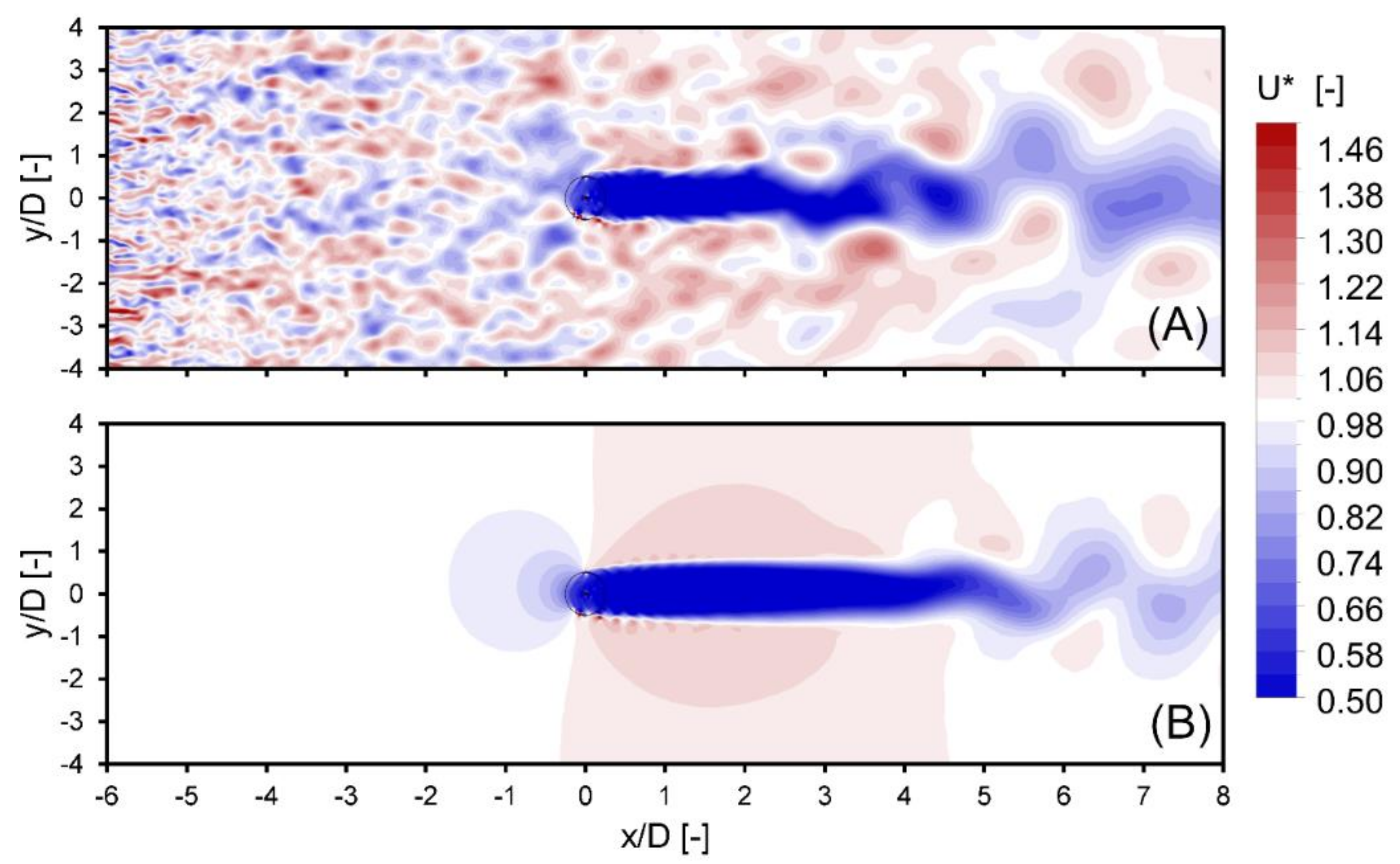
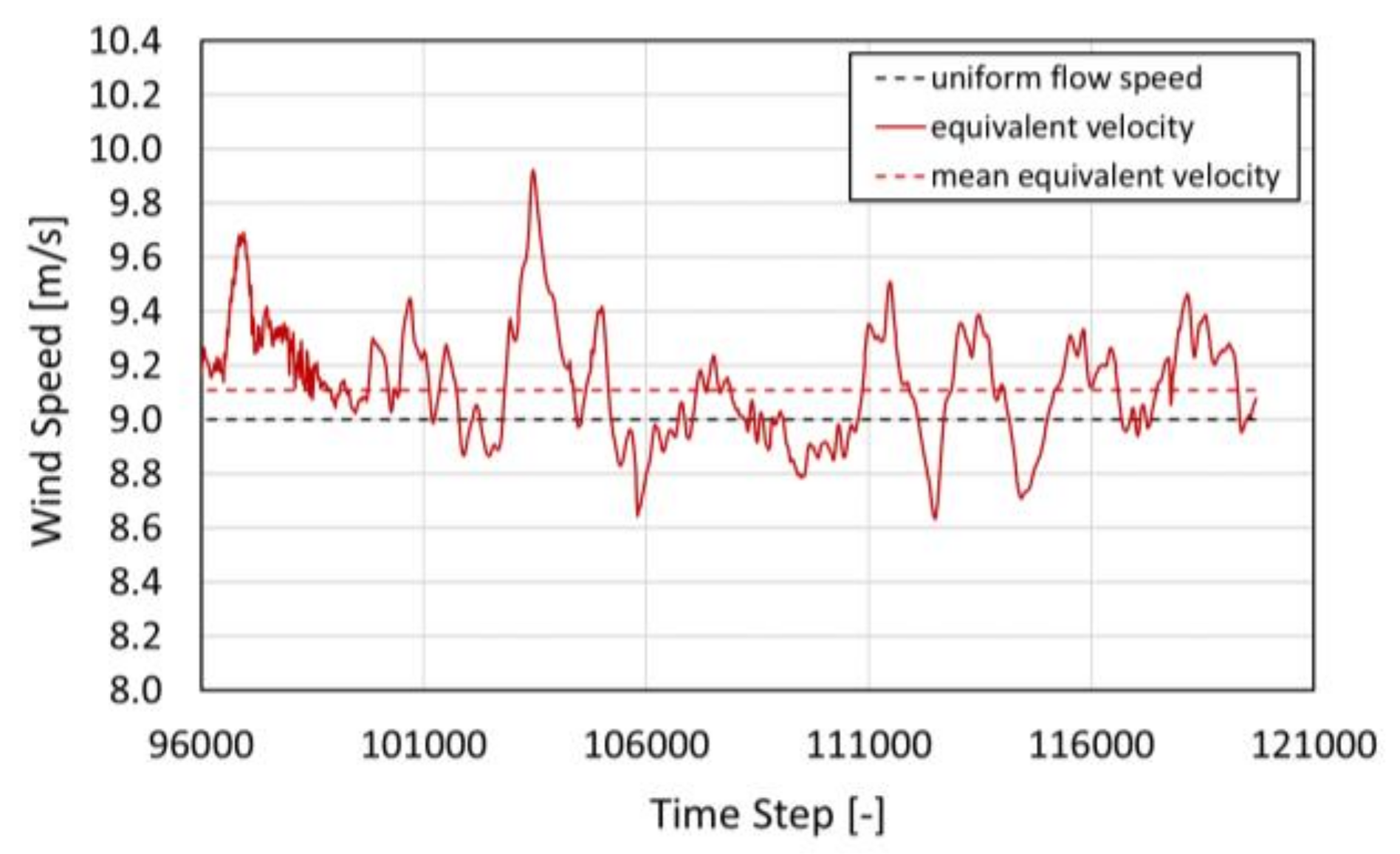
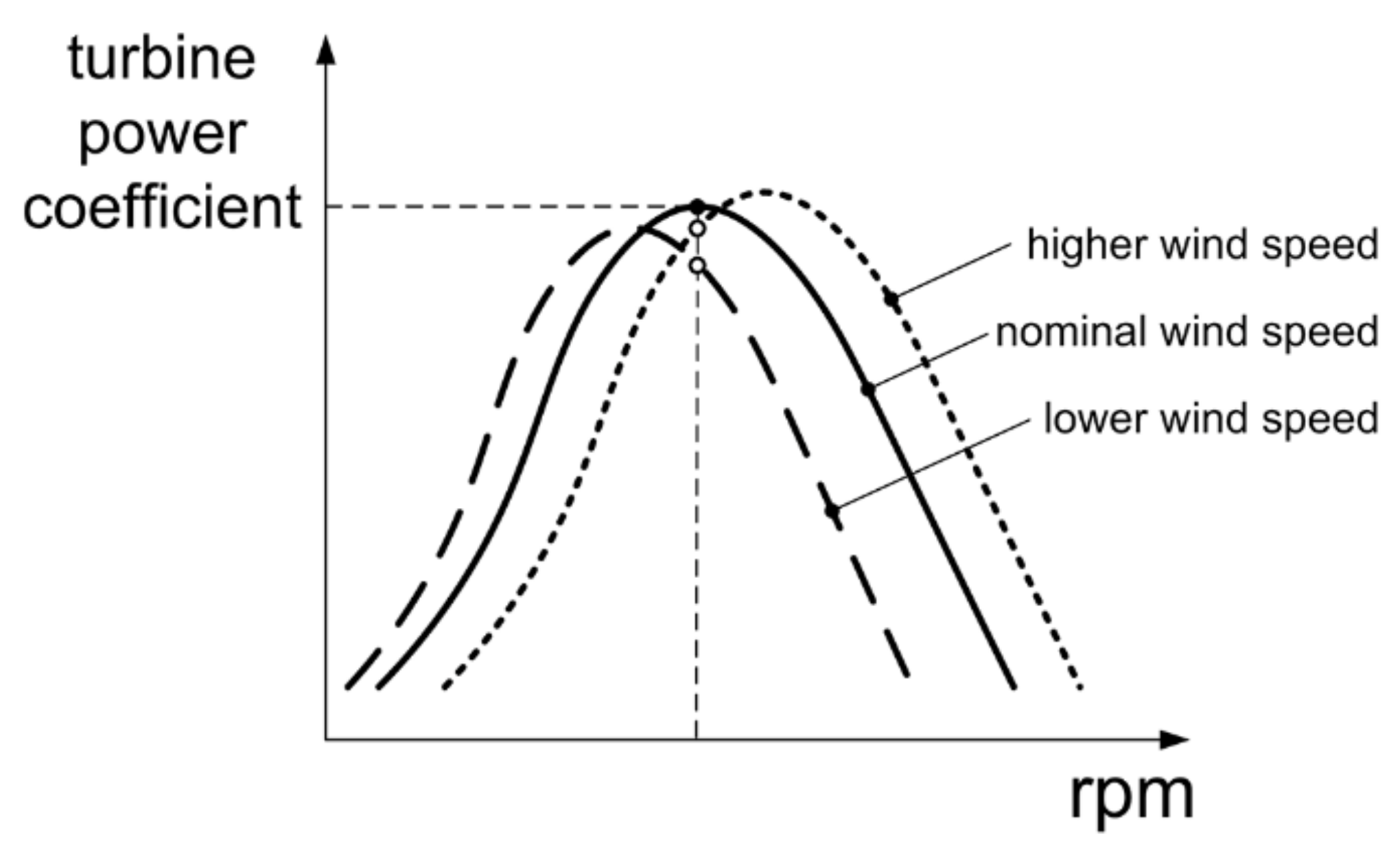
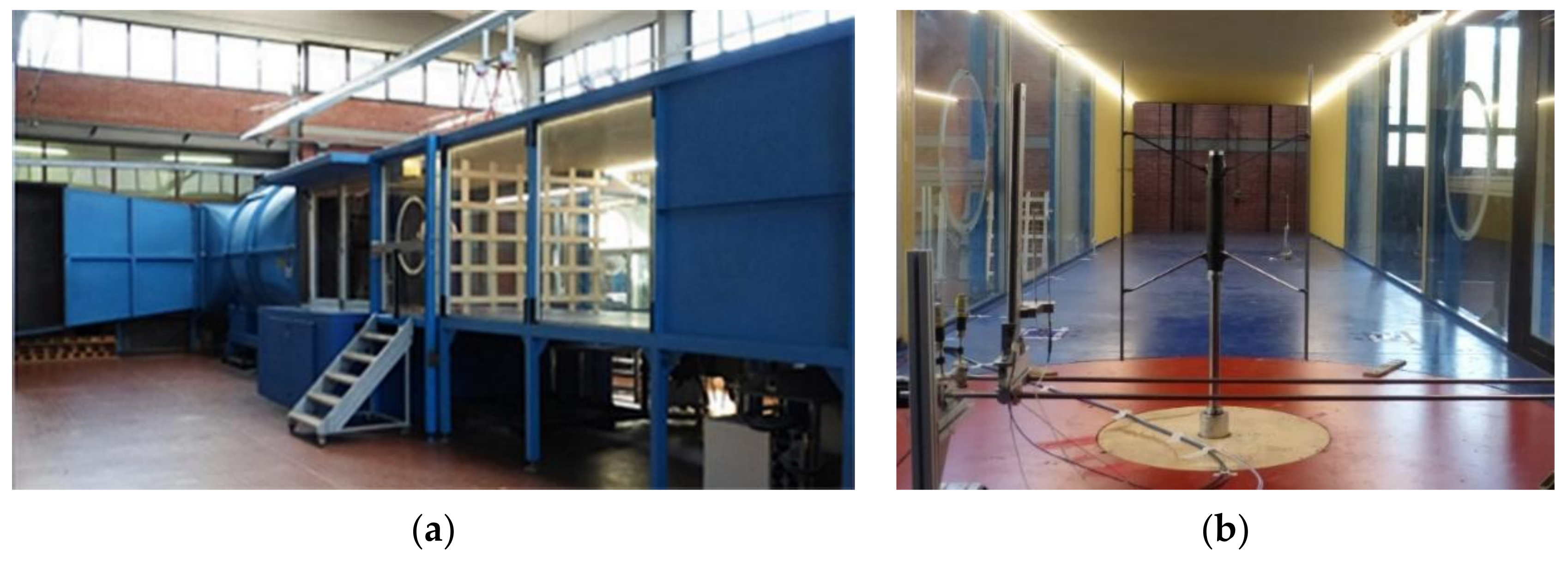
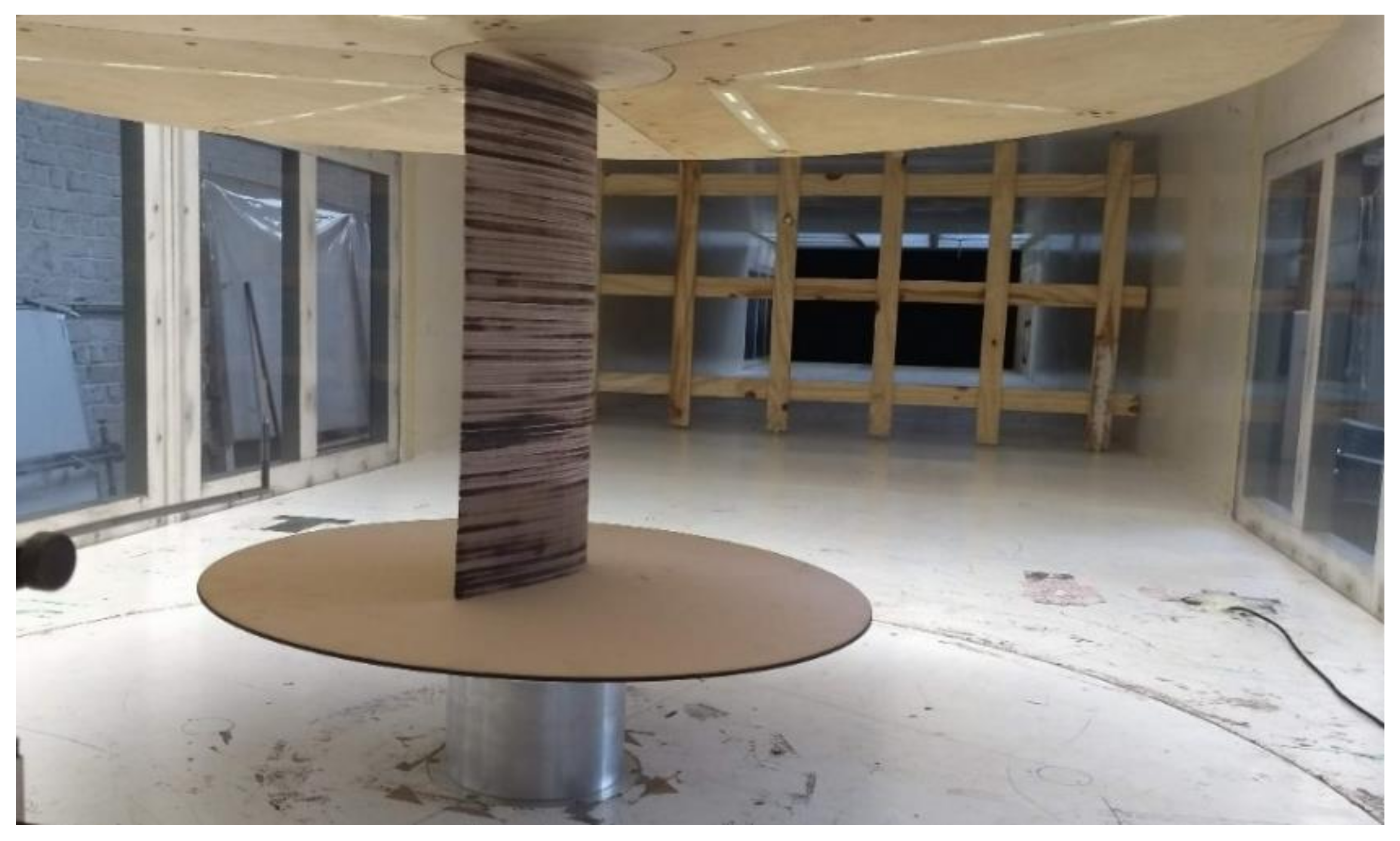
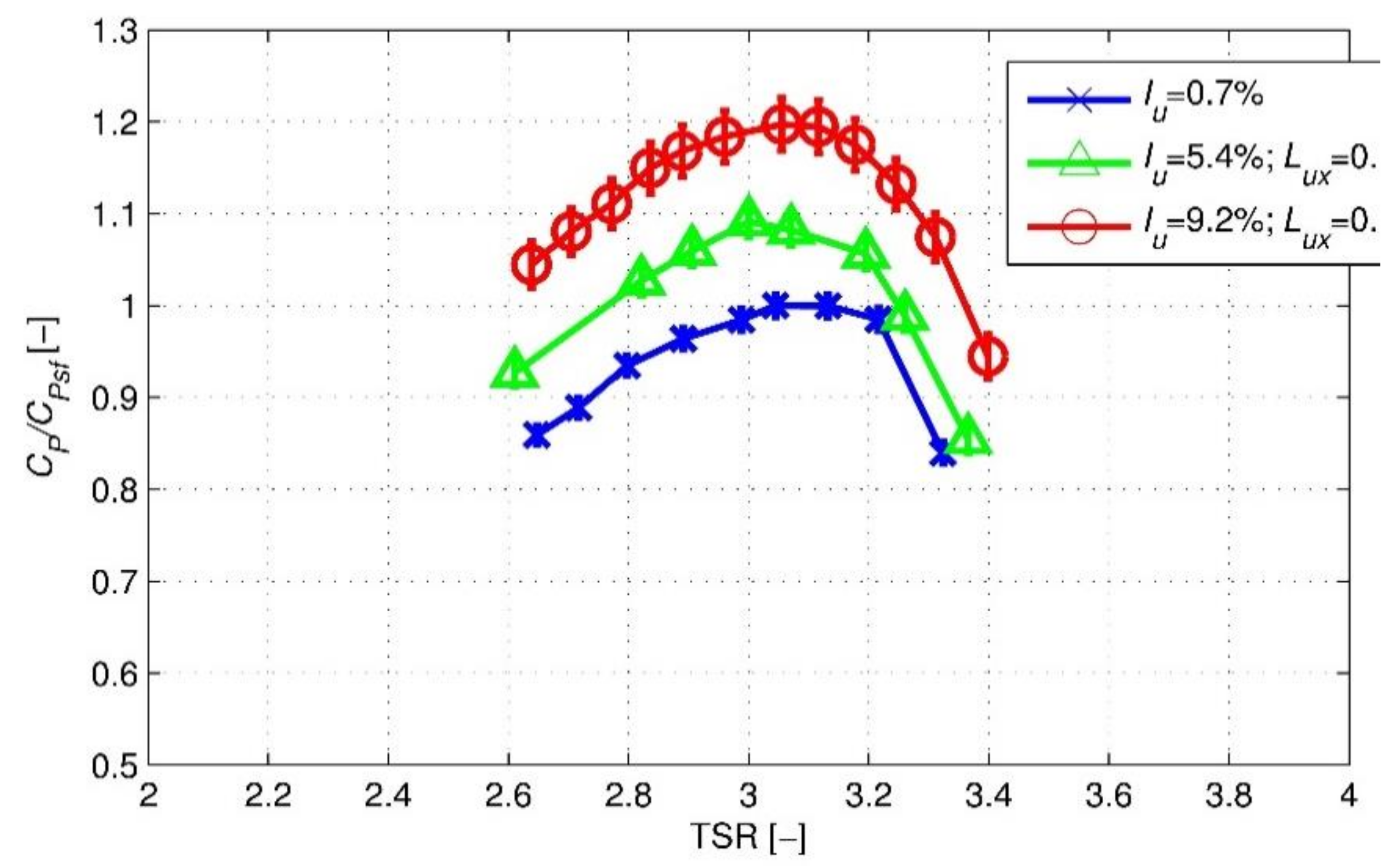
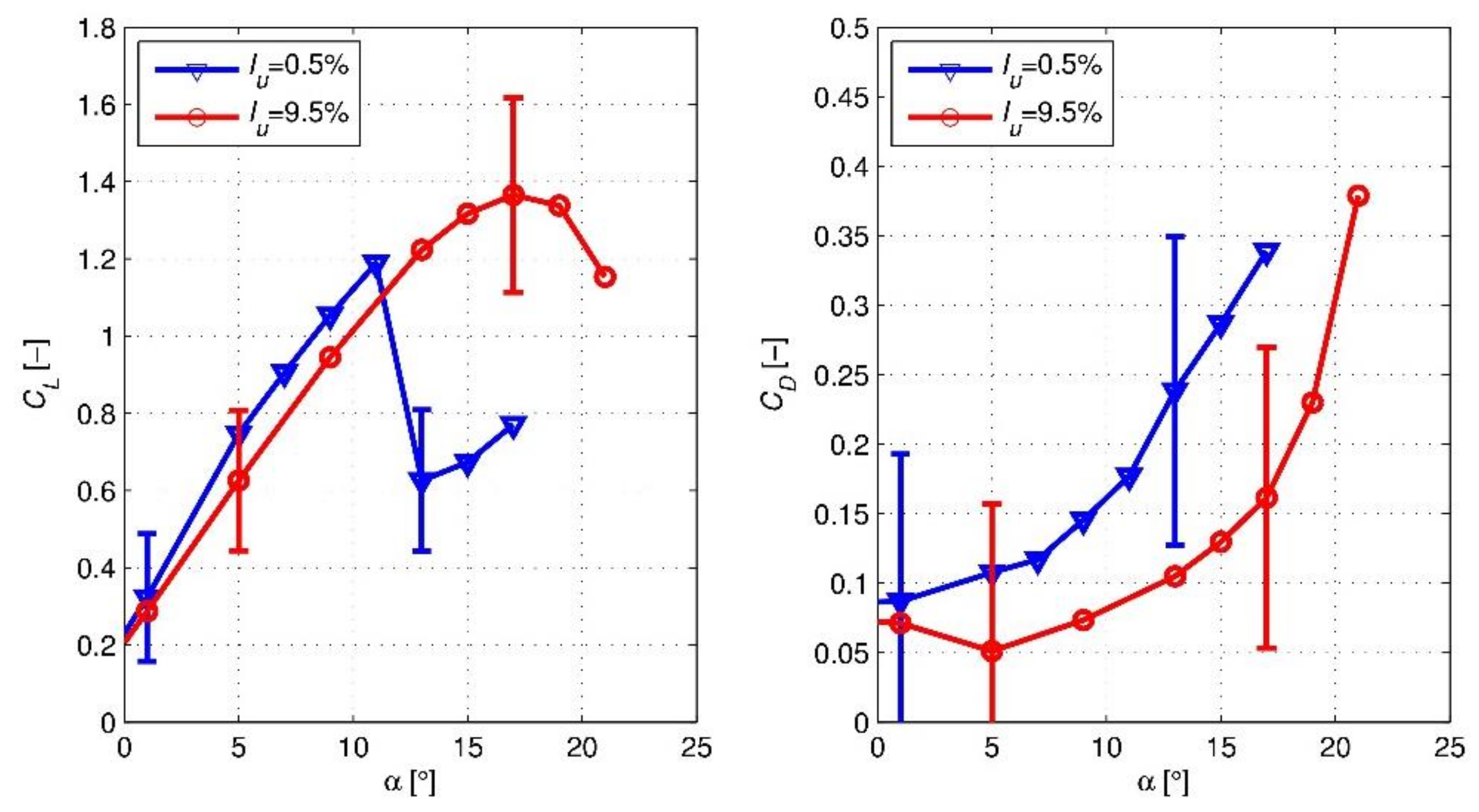
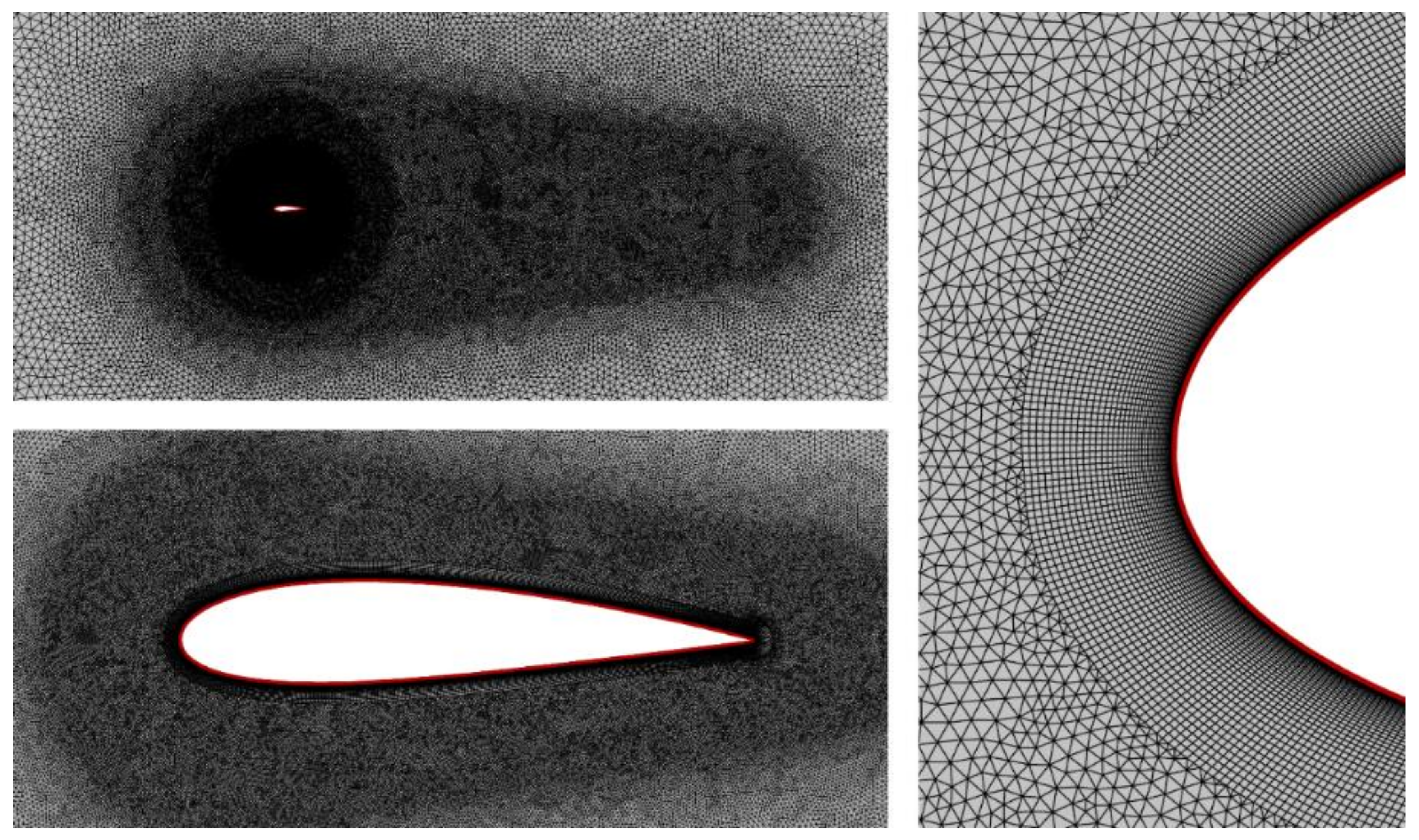
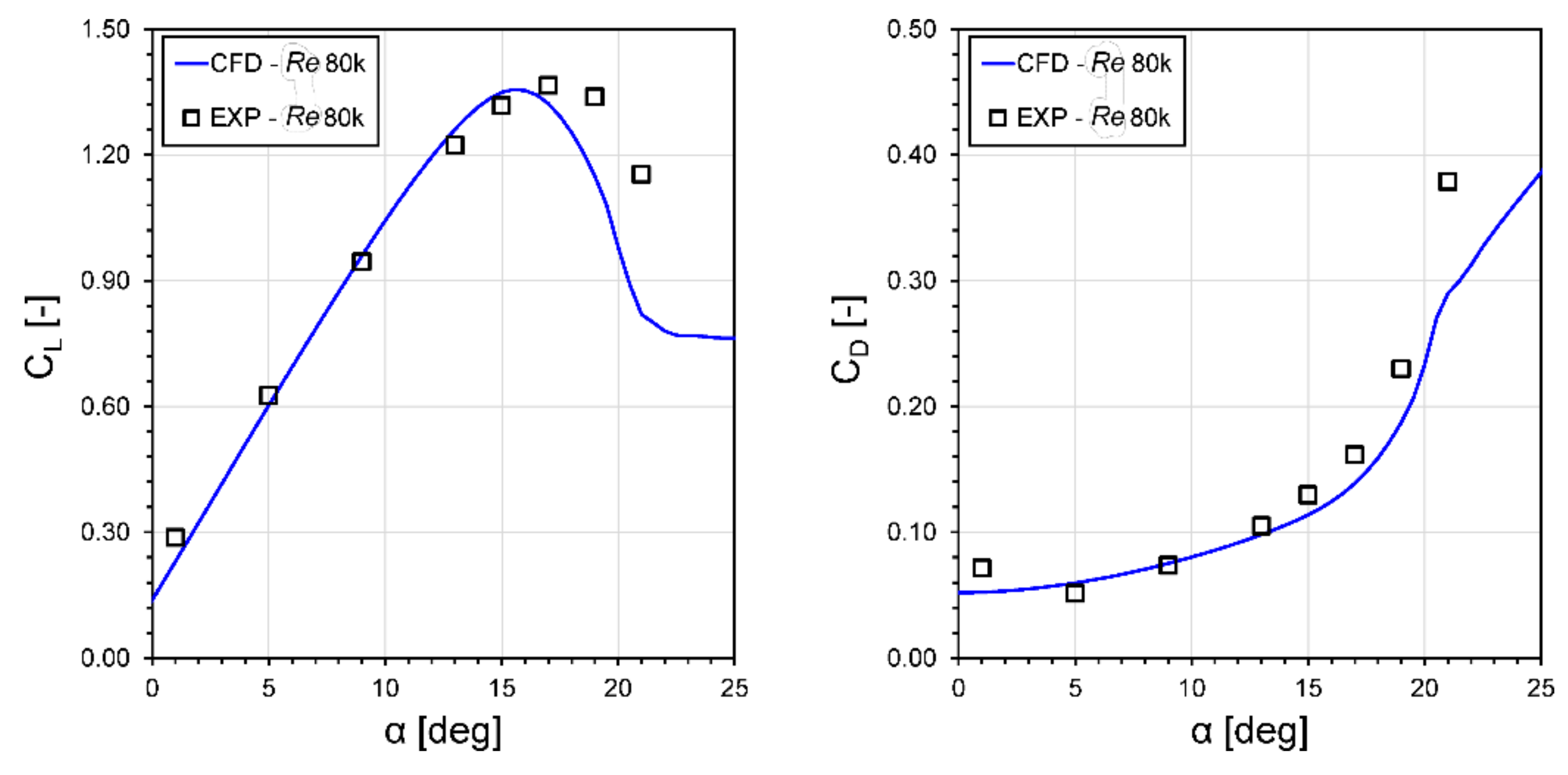
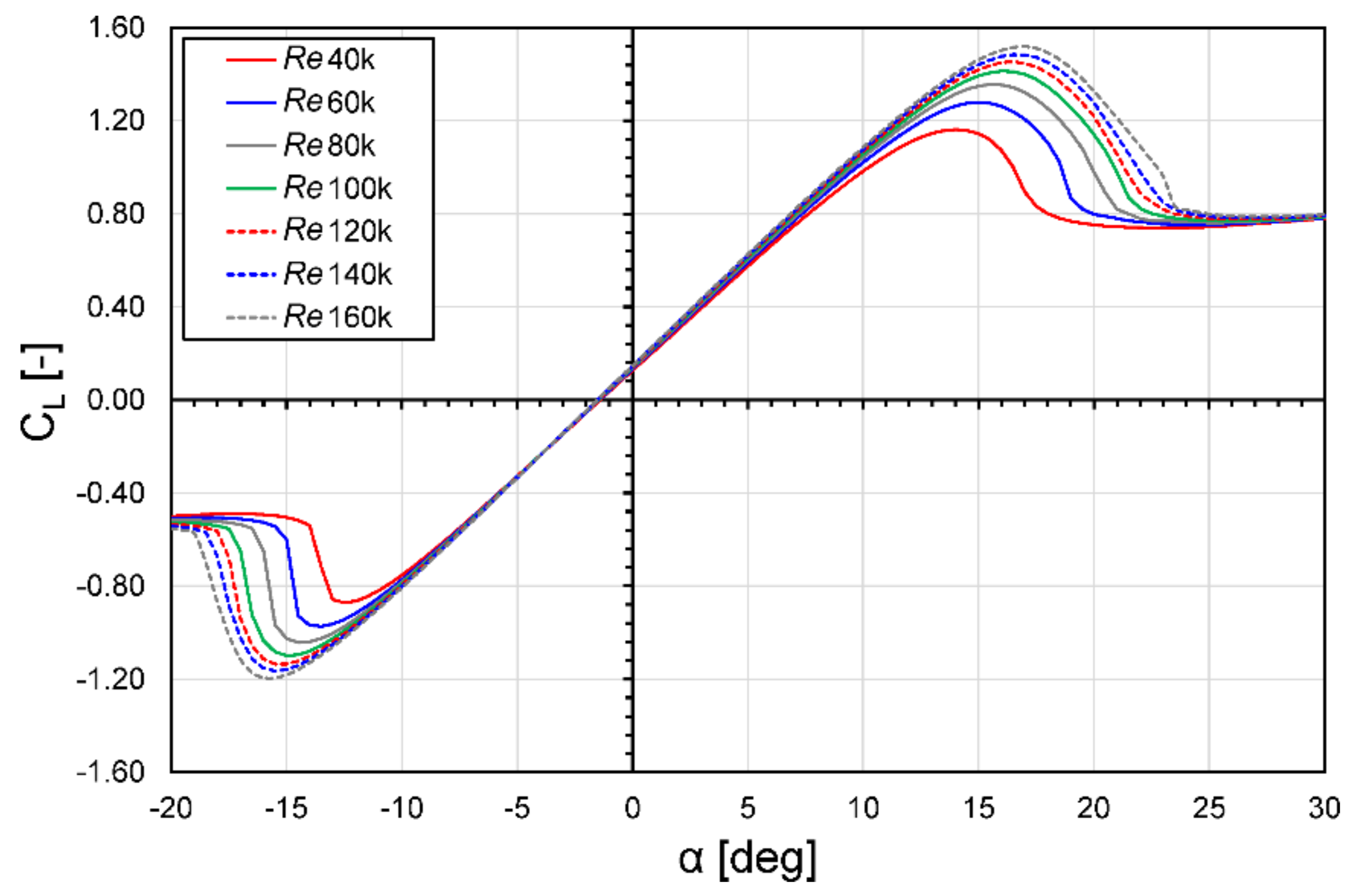
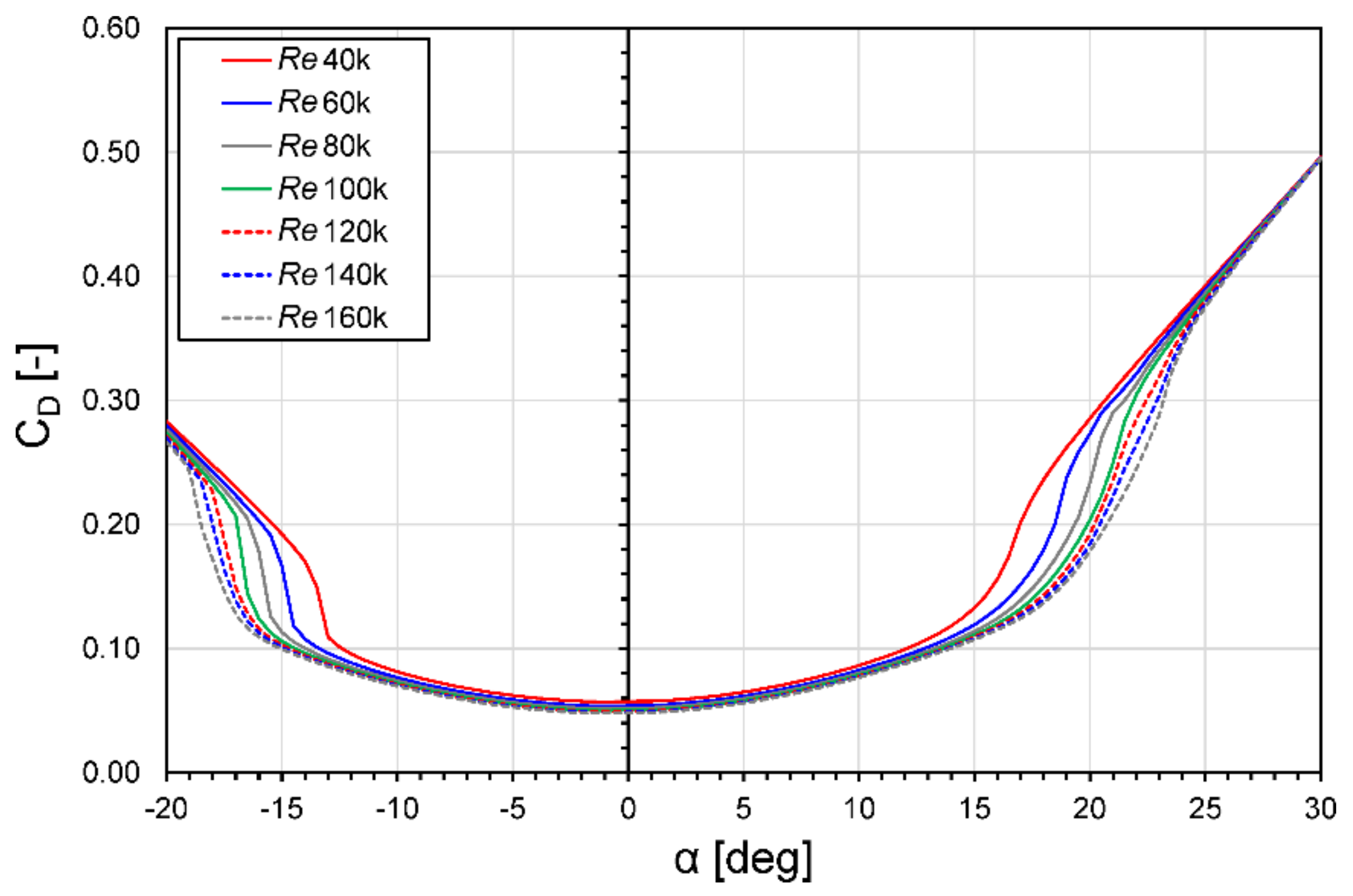
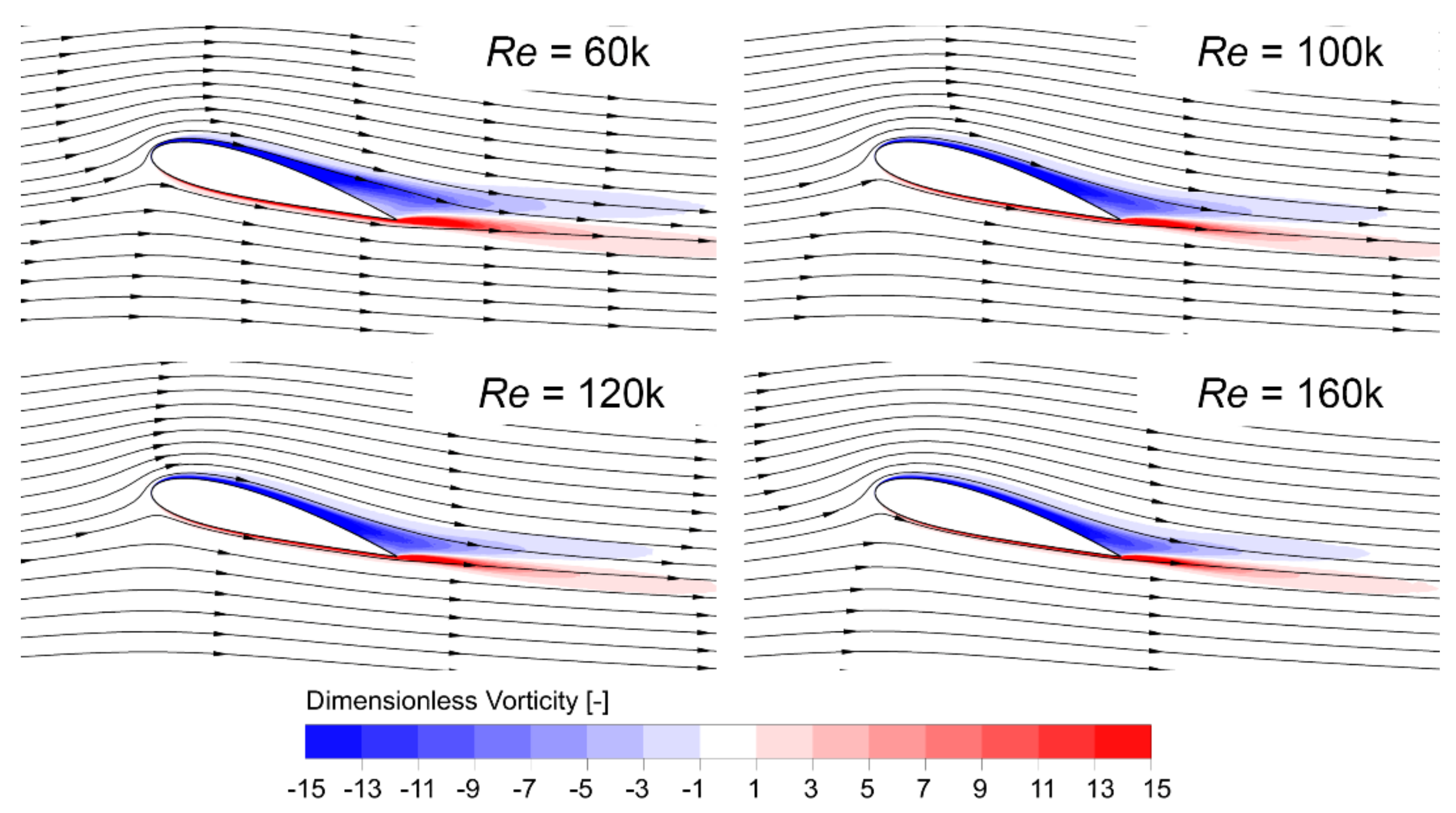

| Condition | Grid Distance x | Mean Iu | Mean Lux |
|---|---|---|---|
| Smooth flow | - | 0.7% | - |
| Low Iu | 7.6 m | 5.4% | 18 cm |
| High Iu | 3.75 m | 9.2% | 15 cm |
© 2020 by the authors. Licensee MDPI, Basel, Switzerland. This article is an open access article distributed under the terms and conditions of the Creative Commons Attribution (CC BY) license (http://creativecommons.org/licenses/by/4.0/).
Share and Cite
Balduzzi, F.; Zini, M.; Molina, A.C.; Bartoli, G.; De Troyer, T.; Runacres, M.C.; Ferrara, G.; Bianchini, A. Understanding the Aerodynamic Behavior and Energy Conversion Capability of Small Darrieus Vertical Axis Wind Turbines in Turbulent Flows. Energies 2020, 13, 2936. https://doi.org/10.3390/en13112936
Balduzzi F, Zini M, Molina AC, Bartoli G, De Troyer T, Runacres MC, Ferrara G, Bianchini A. Understanding the Aerodynamic Behavior and Energy Conversion Capability of Small Darrieus Vertical Axis Wind Turbines in Turbulent Flows. Energies. 2020; 13(11):2936. https://doi.org/10.3390/en13112936
Chicago/Turabian StyleBalduzzi, Francesco, Marco Zini, Andreu Carbó Molina, Gianni Bartoli, Tim De Troyer, Mark C. Runacres, Giovanni Ferrara, and Alessandro Bianchini. 2020. "Understanding the Aerodynamic Behavior and Energy Conversion Capability of Small Darrieus Vertical Axis Wind Turbines in Turbulent Flows" Energies 13, no. 11: 2936. https://doi.org/10.3390/en13112936
APA StyleBalduzzi, F., Zini, M., Molina, A. C., Bartoli, G., De Troyer, T., Runacres, M. C., Ferrara, G., & Bianchini, A. (2020). Understanding the Aerodynamic Behavior and Energy Conversion Capability of Small Darrieus Vertical Axis Wind Turbines in Turbulent Flows. Energies, 13(11), 2936. https://doi.org/10.3390/en13112936








